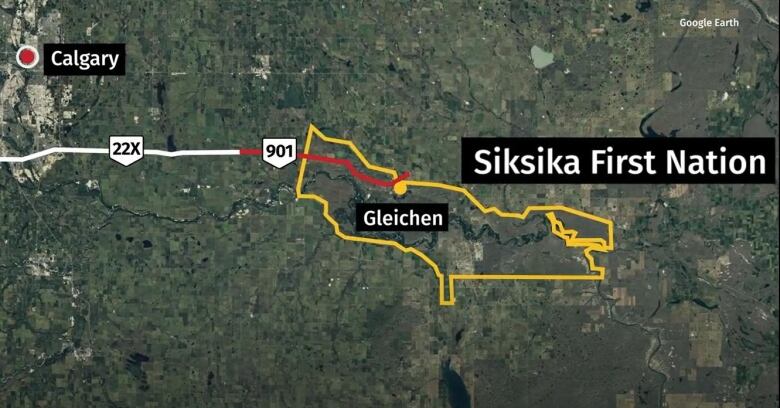Siksika urges lower speeds or tolls along highway through its land to prevent more deaths
Too many transport vehicles make Highway 901 unsafe after a pedestrian killed by semi, First Nation says
Siksika First Nation is meeting with Alberta's transportation minister on Monday to urge the department to make a provincial highway that runs through the reserve safer for the community after a young man died on that road last month.
Bradley Black Horse, 30, was walking home along Highway 901 when he was struck and killed by a semi heading east at about 9 p.m. onJanuary5.
- WATCH ABOVE | See how close some semis areto pedestrians when driving the highway
The band's chief and council say Highway 901, which is an undivided highway that connects Highway 22Xin southeast Calgary to Highway 1 east of Gleichen,has become dangerous for members because of the increasing number of transport trucks using it.
They say it has become a way to quickly access southeast Calgary, which is located about 100 kilometres away from the First Nation, and bypass a commercial weigh scale along the TransCanada. There are no weigh scales on Highway 901.
"One life lost is too many, and I can't imagine the catastrophic traumatic occurrence if one of these units hit a busload of kids, so we're doing whatever it takes to keep our people safe," said Reuben Buck Breaker, a Siksika First Nation councillor.
- WATCH BELOW | Hear from one mother asking for changes after losing her son
Following the death of Black Horse, leadership within the First Nation fired off a letter to the Minister of Transportation, Ric McIver.
It sought to bring attention to the increased truck traffic volume and the community's concerns by suggesting the province reduce the speed limit from 100 km/h to 80 km/h to allow for better reaction time.
They also suggested the installation of tolls or a weigh scale along the 25-kilometre stretch of highway that passes through the First Nation in order to help deter larger transport vehicles.
RCMP are still waiting on reports from the collision analyst and the medical examiner to determine exactly what happened that night, so it isnot known if these changes would have spared his life.

However,they say one witnessthe driver of the vehicle ahead of the semisaid they had to swerve to miss Black Horse, but the semi was unable to.
But Black Horse's mother, DebbieYellowfly, believes a lower speed, less traffic and lights along that road may have helped.
"He was a real cautious guy, he knew where he was walking, and I know he wasn't in the path of that truck, he was on the side [the shoulder]," said Yellowfly."After that I was in so much shock, my heart was so shattered."
A shorter route to Calgary
Yellowfly says her son's death has saddened and angered the community, with some going as far as to suggest putting up a blockade unless changes are made to make the highway safer,because she says many in the community walk along that road, and have for decades.
"People walk to get exercise, people walk to get to town, people walk because they don't have transportation, people get picked up because they give rides to them to get to town and it's going to continue like this, it's not going to change," said Yellowfly.
Yellowfly says she remembers when that paved provincial highway used to be a nature trail. Now she says she sees more semis on it then she does on the TransCanada highway.
"I feel there is so much transport truck drivers going through, sometimes there will be a convoy of seven it's becoming a point where it's a main road for them," said Yellowfly.

Bow River Conservative MP Martin Shields, who represents the First Nation,says he travels thathighway frequently and has watched as the traffic has grown, as well as the communities around it, so he understands the Nation's concerns.
"I think the chief and council of Siksika, rightly so, need to be working to see what they can do to resolve that situation," added Shields.
He says as the trucking industry has expanded in south Calgary,so has the number of commercial trucks using Highway 901.
"A lot of trucking companies have found it because it is a shorter route into Calgary coming east or west, if you are in the south of Calgary," said Shields.
The province says about 2,750 vehicles travel that highway daily according to data collected in 2019, andthe majority are passenger vehicles, with big trucks and semis making up about 25 per cent of the total.
The head of the Alberta Transport Motor Association, Chris Nash, says trucking is up everywhere, so he was not surprised to hear about the growth along that highway.
But he says he is not that familiar with Highway 901,nor has he had time to speak to any of the truckers who use it, so he is hesitant to comment on the concerns or the suggestions, such as lowering the speed limit.
"That's something obviously our government would have to be part of, but as an industry, [we would] definitely be happy to sit down and listen to the concerns of where that is," said Nash.
He also said Alberta has a very safe industry, for the most part.
Speed limit drop, weigh scale, tolls
The chief and council shared the January 13letter they sent to the Ministry of Transportation with CBC News.
It states, according to RCMP statistics, that there have been 17 deaths along four highways near Sisksika, between 2004 and 2020. Of those, six happened along Highway 901.
These stats don't include the death of Black Horse last month.
In the letter the band leadership asks to meet with Transportation Minister Ric McIver to come up with a number of solutions including the lowering of the speed limit.
There is one section that already drops to 70 km/hour through an intersection by Gleichen.
The letter also suggests the province install a camera system to ensure the speed limit is enforced, a weigh station "to deter commercial vehicles from using Siksika as a pass through," and a toll system for commercial vehicles.
The First Nation also recommends working with the province and the federal government to build a pathway for pedestrians beside the highway.
And Yellowfly would like to see lights installed to help drivers see better at night.

Coun.Breaker says Siksika has asked the province to reduce the speed limit in the past without any success. The First Nation can't reduce the speed on its own because the province owns the road.
Breaker says the last request was prompted by other serious incidents that included a collisionbetween a school bus and a semi. Thankfully, he says, no one was injured in that crash.
"We pursued the Alberta Government and they said no, so here we are again.How many lives does it have to take for Alberta to listen?" said Breaker.
"We're not going to be quiet anymore, we're going to go right till the end until change is made."
Grumblings of a blockade
Since the letter was sent, the Siksika chief and council say they heard back from the transportation minister's office last week and have a meeting set up with him Monday.
CBC News reached out to the transportation ministry. In response, the Minister Ric McIver issued this statement:
"I was sad to learn of the death of the Siksika resident walking on Highway 901. I wish to express condolences on behalf of myself and the government of Alberta to their family and friends. We received a letter from Siksika Nation regarding the speed limit on Highway 901, dated January 13. Alberta Transportation is carefully considering the recommendations from Chief Crowfoot and the Council. Sadly this most recent death makes our review of the nation's request even more urgent."
The chief and council also passed a motion on February 3 to reduce the speed limit of Highway 901 to 80 km/h within the First Nation's borders. The notice has also been sent to the province.

It states it is effective April 1, 2021.
Breaker says that gives both sides ample time to work together and resolve the issue.
But Breaker sayssome in the communityaren't as optimistic about coming to a resolution, and he, too, has heard grumblings of a blockade if the province doesn't respond to the community's request for changes.
"If that's what they want to do, we can't stop them, but if that's what it takes to get the province's attention, I'm sure we will stand with them," said Breaker.
Yellowfly says she wouldn'twant to see the community's anger get to that point.
Rather, she hopes her son's death will be enough to raise awareness and promptchange.
"It will bring a bit of a closure for me, it's part of my healing also," she said.
"To me it feels like he is still around.I loved him so much."














_(720p).jpg)


 OFFICIAL HD MUSIC VIDEO.jpg)
.jpg)



























































































